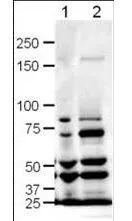
Western blot using GeneTexs Affinity Purified anti-SLIT-1 antibody shows detection of SLIT-1 in rat (lane 1) and mouse (lane 2) brain lysates. The expected molecular weight for SLIT-1 is 168 kDa. Approximately 20 microg of each lysates was run on a SDS-PAGE and transferred onto nitrocellulose followed by reaction with a 1:500 dilution of anti-SLIT-1 antibody. Signal was detected using standard techniques. Note: The smaller strong bands observed in this blot are likely SLIT-1 cleavage products. A number of cleavage products for both Slit1 and Slit2 are reported in the literature resulting from alternate splicing and range from ~40kDa -160kDa.
SLIT1 antibody
GTX48742
ApplicationsWestern Blot, ELISA
Product group Antibodies
ReactivityMouse, Rat
TargetSlit1
Overview
- SupplierGeneTex
- Product NameSLIT1 antibody
- Delivery Days Customer9
- Application Supplier NoteWB: 1:500-1:2000. ELISA: 1:10000-1:50000. *Optimal dilutions/concentrations should be determined by the researcher.Not tested in other applications.
- ApplicationsWestern Blot, ELISA
- CertificationResearch Use Only
- ClonalityPolyclonal
- Concentration1.2 mg/ml
- ConjugateUnconjugated
- Gene ID20562
- Target nameSlit1
- Target descriptionslit guidance ligand 1
- Target synonymsmKIAA0813; S; Slil1; slit homolog 1 protein; slit-1
- HostRabbit
- IsotypeIgG
- Protein IDQ80TR4
- Protein NameSlit homolog 1 protein
- Scientific DescriptionSLIT-1 (also known as KIAA0813, MEGF4, multiple epidermal growth factor-like domains 4 and Slit homolog 1 protein) is a Slit protein. This protein is a ligand for the Roundabout (Robo) receptors and acts as guidance cues in axonal migration/navigation during neural development, at the ventral midline of the neural tube. Slit1 and Slit2 are essential for midline guidance in the forebrain by acting as repulsive signals preventing inappropriate midline crossing by axons projecting from the olfactory bulb. Each SLIT gene encodes a putative secreted protein, which contains conserved protein-protein interaction domains including leucine-rich repeats and epidermal growth factor-like motifs, similar to those of the Drosophila protein. In situ hybridization studies indicated that the rat SLIT-1 mRNA was specifically expressed in the neurons of fetal and adult forebrains. This data suggests that the SLIT genes form an evolutionarily conserved group in vertebrates and invertebrates, and that the mammalian SLIT proteins may participate in the formation and maintenance of the nervous and endocrine systems by protein-protein interactions. Alternative splicing isoforms have been identified for Slit1 protein.
- ReactivityMouse, Rat
- Storage Instruction-20°C or -80°C,2°C to 8°C
- UNSPSC12352203
